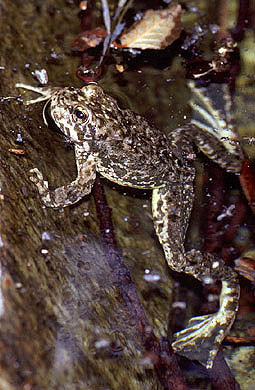 Are Pacific Chorus Frogs, Pseudacris regilla, driving other amphibians to extinction? A recent study revealed that the tiny frogs often carry a fungus (Batrachochytrium dendrobatidis, or Chytrid) that has been implicated in the extinction of 200+ amphibian species. Chorus Frogs seem largely immune to the disease, but may spread it to other species that share their habitat, including the endangered Mountain Yellow-Legged Frog, Rana mucosa. However, I believe there is more to the story…
Are Pacific Chorus Frogs, Pseudacris regilla, driving other amphibians to extinction? A recent study revealed that the tiny frogs often carry a fungus (Batrachochytrium dendrobatidis, or Chytrid) that has been implicated in the extinction of 200+ amphibian species. Chorus Frogs seem largely immune to the disease, but may spread it to other species that share their habitat, including the endangered Mountain Yellow-Legged Frog, Rana mucosa. However, I believe there is more to the story…
Resilient Chytrid Carriers
Researchers from San Francisco State University and the San Diego Zoo have confirmed high levels of Chytrid fungus among Pacific Chorus Frogs in California’s Sierra Nevada Mountains. Unlike many amphibians, Chorus Frogs seem relatively unaffected by the fungus.
As Pacific Chorus Frogs have a huge natural range and readily colonize new habitats, it is feared that they will spread the highly contagious disease to other amphibians. In fact, Chorus frogs often live near Yellow-Legged Frogs, an endangered species that has suffered a 90% decline in numbers in recent years.
A Protective Bacterium
The study also indicates that bacteria on the skin of Chorus Frogs may help them to survive Chytrid infections. Upon reading this, I recalled earlier studies of a similar nature, and checked into the topic.
It seems that Chytrid-protective bacteria have also been isolated from the skin of Red-Backed Salamanders, Plethodon cinereus and Mountain Yellow-Legged Frogs (the endangered species mentioned above). I do not know whether the bacterium found on these 2 species – Janthinobacterium lividum – is the one that colonizes Chorus Frog skin.
An article in Scientific American (July 12, 2010), reported that J. lividum can be cultured in the lab, and that amphibians with the highest J. lividum populations on their skin had the greatest immunity to Chytrid infection. Wild Mountain Yellow-Legged Frogs were to be inoculated with the bacterium to see if immunities would develop. I’m looking into the status of this project, and will report any new findings in the future. Please see the article below for additional information.
Researchers in Central America are also studying frogs that were found alive after Chytrid swept through their habitats. Perhaps these rare survivors hold the key to understanding this devastating disease phenomenon.
Don’t Blame Chorus Frogs!
 Before we cast too much “blame” on Pacific Chorus Frogs (African Clawed Frogs have been cast as Anuran “Typhoid Mary’s” as well), it should be noted that a host of other factors are likely at work. Pollution, climate change, habitat alteration and the like can weaken immune systems, rendering a species susceptible to Chytrid attack.
Before we cast too much “blame” on Pacific Chorus Frogs (African Clawed Frogs have been cast as Anuran “Typhoid Mary’s” as well), it should be noted that a host of other factors are likely at work. Pollution, climate change, habitat alteration and the like can weaken immune systems, rendering a species susceptible to Chytrid attack.
In fact, Yellow Legged Frogs are exposed to pollution, climate change and introduced predators (trout)…perhaps this partially explains why protective skin bacteria seem not to affect their survival when exposed to Chytrid.
Other Chytrid Concerns: Amphibians as Food and Bait
Three to four billion frogs are collected from the wild each year for the food trade…many more are likely not recorded. The USA, not a major consumer, imports 4.4 million pounds of live frogs annually. Shipping live frogs to foreign countries has been tied to Chytrid outbreaks in areas that had formerly been free of the deadly amphibian disease.
I’ve long been involved in frog confiscations in NYC and am convinced that the trade is adding to the problems already faced by native species; please see this article to learn how you can help.
While Eastern Tiger Salamanders are protected in several states, the larvae of western races are widely used as fishing bait (hooked while alive, no less!). Researchers from the National Science Foundation have documented high levels of Chytrid infection and Ranaviruses in bait trade salamanders.
Chytrid is a complex problem, but bait and food trade issues seem fairly straightforward…yet little is being done. Please see this article to learn how to register your opposition to the use of amphibians as fishing bait.
Further Reading
Chorus Frog research article (abstract)
Bacteria Offers Chytrid Immunity
Mountain Yellow-legged Frog Conservation
Rana mucosa photo by Chris Brown (http://www.werc.usgs.gov) [Public domain], via Wikimedia Commons
Pacific Tree Frog by Oregon Department of Fish & Wildlife (1010927_tree_frog_barnes_odfw) [CC-BY-SA-2.0 (www.creativecommons.org/licenses/by-sa/2.0)], via Wikimedia Commons
 That Reptile Blog – Reptile, Amphibian and Exotic Pet Care and Information
That Reptile Blog – Reptile, Amphibian and Exotic Pet Care and Information



How do you know the frog has this sickness??
Hello Kelly,
Thanks for your interest; symptoms vary, but usually include red skin, excessive shedding, abnormal posture. However, these are typical of many other diseases as well. Chytrid infection can only be accurately diagnosed by lab tests. Please see this article for more info on the disease and its treatment.
Please let me know if you need any further information. Good luck, enjoy and please keep me posted.
Best regards, Frank Indiviglio.